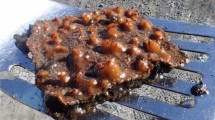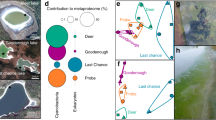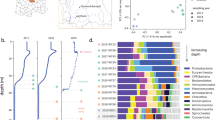Abstract
We studied the diversity of all forms of the RuBisCO large subunit-encoding gene cbbL in three RuBisCO uncharacterized hydrothermal vent communities. This diversity included the archaeal cbbL and the forms IC and ID, which have not previously been studied in the deep-sea environment, in addition to the forms IA, IB and II. Vent plume sites were Fryer and Pika in the Mariana arc and the Suiyo Seamount, Izu-Bonin, Japan. The cbbL forms were PCR amplified from plume bulk microbial DNA and then cloned and sequenced. Archaeal cbbL was detected in the Mariana samples only. Both forms IA and II were amplified from all samples, while the form IC was amplified only from the Pika and Suiyo samples. Only the Suiyo sample showed amplification of the form ID. The form IB was not recorded in any sample. Based on rarefaction analysis, nucleotide diversity and average pairwise difference, the archaeal cbbL was the most diverse form in Mariana samples, while the bacterial form IA was the most diverse form in the Suiyo sample. Also, the Pika sample harbored the highest diversity of cbbL phylogenetic lineages. Based on pairwise reciprocal library comparisons, the Fryer and Pika archaeal cbbL libraries showed the most significant difference, while Pika and Suiyo showed the highest similarity for forms IA and II libraries. This suggested that the Fryer supported the most divergent sequences. All archaeal cbbL sequences formed unique phylogenetic lineages within the branches of anaerobic thermophilic archaea of the genera Pyrococcus, Archaeoglobus, and Methanococcus. The other cbbL forms formed novel phylogenetic clusters distinct from any recorded previously in other deep-sea habitats. This is the first evidence for the diversity of archaeal cbbL in environmental samples.




Similar content being viewed by others
References
Ashida H, Saito Y, Kojima C, Kobayashi K, Ogasawara N, Yokota A (2003) A functional link between RuBisCO-like protein of Bacillus and photosynthetic RuBisCO. Science 302:286–290
Beatty J, Overmann J, Lince MT, Manske AK, Lang AS, Blankenship RE, Van Dover CL, Martinson TA, Plumley FG (2005) An obligately photosynthetic bacterial anaerobe from a deep-sea hydrothermal vent. Proc Natl Acad Sci USA 102:9306–9310
Bult CJ, White O, Olsen GJ, Zhou L, Fleischmann RD, Sutton GG, Blake JA, FitzGerald LM, Clayton RA, Gocayne JD, Kerlavage AR, Dougherty BA, Tomb JF, Adams MD, Reich CI, Overbeek R, Kirkness EF, Weinstock KG, Merrick JM, Glodek A, Scott JL, Geoghagen NS, Venter JC (1996) Complete genome sequence of the methanogenic archaeon, Methanococcus jannaschii. Science 273:1058–1073
Campbell BJ, Cary SC (2004) Abundance of reverse tricarboxylic acid cycle genes in free-living microorganisms at deep-Sea hydrothermal vents. Appl Environ Microbiol 70:6282–6289
Delaney J, Kelley D, Lilley M, Butterfield D, Baross J, Wilcock W, Embley R, Summit M (1998) The quantum event of oceanic crustal accretion: impacts of diking at Mid-Ocean Ridges. Science 281:222–230
Delwiche C, Palmer J (1996) Rampant horizontal transfer and duplication of RuBisCO genes in eubacteria and plastids. Mol Biol Evol 13:873–882
Deppenmeier U, Johann A, Hartsch T, Merkl R, Schmitz RA, Martinez-Arias R, Henne A, Wiezer A, Baumer S, Jacobi C, Bruggemann H, Lienard T, Christmann A, Bomeke M, Steckel S, Bhattacharyya A, Lykidis A, Overbeek R, Klenk HP, Gunsalus RP, Fritz HJ, Gottschalk G (2002) The genome of Methanosarcina mazei: evidence for lateral gene transfer between bacteria and archaea. J Mol Microbiol Biotechnol 4:453–461
Eisen JA, Nelson KE, Paulsen IT, Heidelberg JF, Wu M, Dodson RJ, Deboy R, Gwinn ML, Nelson WC, Haft DH, Hickey EK, Peterson JD, Durkin AS, Kolonay JL, Yang F, Holt I, Umayam LA, Mason T, Brenner M, Shea TP, Parksey D, Nierman WC, Feldblyum TV, Hansen CL, Craven MB, Radune D, Vamathevan J, Khouri H, White O, Gruber TM, Ketchum KA, Venter JC, Tettelin H, Bryant DA, Fraser CM (2002) The complete genome sequence of Chlorobium tepidum TLS, a photosynthetic, anaerobic, green-sulfur bacterium. Proc Natl Acad Sci USA 99:9509–9514
Elsaied H, Naganuma T (2001) Phylogenetic diversity of ribulose-1,5-bisphosphate carboxylase/oxygenase (RuBisCO) large subunit genes from deep-sea microorganisms. Appl Environ Microbiol 67:1751–1765
Elsaied H, Kimura H, Naganuma T (2002a) Molecular characterization and endosymbiotic localization of the gene encoding d-ribulose 1,5-bisphosphate carboxylase-oxygenase (RuBisCO) form II in the deep-sea vestimentiferan trophosome. Microbiology 148:1947–1957
Elsaied H, Sato M, Naka J, Naganuma T (2002b) Analysis of 16S rRNA and RuBisCO large subunit genes from an abyssal low-temperature vent, Loihi Seamount, Hawaii. Cah Biol Mar 43:403–408
English RS, Williams CA, Lorbach SC, Shively JM (1992) Two forms of ribulose-1,5-bisphosphate carboxylase oxygenase from Thiobacillus denitrificans. FEMS Microbiol Lett 94:111–120
Ezaki S, Maeda N, Kishimoto T, Atomi H, Imanaka T (1999) Presence of a structurally novel type ribulose-bisphosphate caroboxylase/oxygenase in hyperthermophilic archaeon, Pyrococcus kodakaraensis KOD1. J Biol Chem 274:5078–5082
Finn M, Tabita F (2003) Synthesis of catalytically active form III ribulose 1,5-Bisphosphate carboxylase/oxygenase in archaea. J Bacteriol 185:3049–3059
Galagan JE, Nusbaum C, Roy A, Endrizzi MG, Macdonald P, FitzHugh W, Calvo S, Engels R, Smirnov S, Atnoor D, Brown A, Allen N, Naylor J, Stange-Thomann N, DeArellano K, Johnson R, Linton L, McEwan P, McKernan K, Talamas J, Tirrell A, Ye W, Zimmer A, Barber RD, Cann I, Graham DE, Grahame DA, Guss AM, Hedderich R, Ingram-Smith C, Kuettner HC, Krzycki JA, Leigh JA, LI W, Liu J, Mukhopadhyay B, Reeve JN, Smith K, Springer TA, Umayam LA, White O, White RH, Conway de Macario E, Ferry JG, Jarrell KF, Jing H, Macario AJ, Paulsen I, Pritchett M, Sowers KR, Swanson RV, Zinder SH, Lander E, Metcalf WW, Birren B (2002) The genome of M. acetivorans reveals extensive metabolic and physiological diversity. Genome Res 12:532–542
Hurlbert SH (1971) The nonconcept of species diversity: a critique and alternative parameters. Ecology 52:577–586
Kimura H, Sato M, Sasayama Y, Naganuma T (2003) Molecular characterization and in situ localization of endosymbiotic 16S ribosomal RNA and RuBisCO genes in the Pogonophoran tissue. Mar Biotech 5:261–269
Kitano K, Maeda N, Fukui T, Atomi H, Imanaka T, Miki K (2001) Crystal structure of a novel-type archaeal rubisco with pentagonal symmetry. Structure 9:473–481
Klenk H, Clayton R, Tomb J, White O, Nelson KE, Ketchum KA, Dodson RJ, Gwinn M, Hickey EK, Peterson JD, Richardson DL, Kerlavage AR, Graham DE, Kyrpides NC, Fleischmann RD, Quackenbush J, Lee NH, Sutton GG, Gill S, Kirkness EF, Dougherty BA, McKenney K, Adams MD, Loftus B, Venter JC (1997) The complete sequence of the hyperthermophilic sulfate-reducing archaeon Archaeoglobus fulgidus. Nature 390:364–370
Kusian B, Bowien B (1997) Organization and regulation of cbb CO2 assimilation genes in autotrophic bacteria. FEMS Microbiol Rev 21:135–155
Li H, Sawaya M, Tabita F, Eisenberg D (2005) Crystal structure of a RuBisCO-like protein from the green sulfur bacterium Chlorobium tepidum. Structure 13:779–789
Nanba K, King G, Dunfield K (2004) Analysis of facultative lithotroph distribution and diversity on volcanic deposits by use of the large subunit of ribulose 1,5-bisphosphate carboxylase/oxygenase. Appl Environ Microbiol 70:2245–2253
Paul JH, Alfreider A, Wawrik B (2000) Micro- and macrodiversity in rbcL sequences in ambient phytoplankton populations from the southeastern Gulf of Mexico. Mar Ecol Prog Ser 198:9–18
Rajagopalan R, Altekar W (1994) Characterization and purification of ribulose-bisphosphate carboxylase from heterotrophically grown halophilic archaebacterium, Haloferax mediterranei. Eur J Biochem 221:863–869
Robinson J, Stein J, Cavanaugh C (1998) Cloning and sequencing of a form II ribulose-1,5-bisphosphate carboxylase/oxygenase from the bacterial symbiont of the hydrothermal vent tubeworm Riftia pachyptila. J Bacteriol 180:1596–1599
Schneider S, Roesseli D, Excoffier L (2000) Arlequin version 2.000, a software for population genetics data analysis. Genetics and Biometry Laboratory, University of Geneva, Geneva
Schwedock J, Harmer T, Scott K, Hektor H, Seitz A, Fontana M, Distel D, Cavanaugh C (2004) Characterization and expression of genes from the RubisCO gene cluster of the chemoautotrophic symbiont of Solemya velum: cbbLSQO. Arch Microbiol 182:18–29
Selesi D, Schmid M, Hartmann A (2005) Diversity of green-like and red-like ribulose-1,5-bisphosphate carboxylase/Oxygenase large-subunit genes (cbbL) in differently managed agricultural Soils. Appl Environ Microbiol 71:175–184
Shinozaki K, Yamada C, Takahata N, Sugiura M (1983) Molecular cloning and sequence analysis of the cyanobacterial gene for the large subunit of ribulose-1,5-bisphosphate carboxylase/oxygenase. Proc Natl Acad Sci USA 80:4050–4054
Simberloff D (1978) Use of rarefaction and related methods. In: Dickson KL et al (eds) Biological data in water pollution assessment quantitative and statistical analyses. American Society for Testing and Materials, Philadelphia, pp 150–165
Singleton D, Furlong M, Rathbun S, Whitman W (2001) Quantitative comparisons of 16S rRNA gene sequence libraries from environmental samples. Appl Environ Microbiol 67:4374–4376
Stein JL, Haygood M, Felbeck H (1990) Nucleotide sequence and expression of a deep-sea ribulose-1,5-bisphosphate carboxylase gene cloned from a chemoautotrophic bacterial endosymbiont. Proc Natl Acad Sci USA 87:8850–8854
Sunamura M, Higashi Y, Miyako C, Ishibashi J, Maruyama A (2004) Two bacterial phylotypes are predominant in the Suiyo Seamount hydrothermal plume. Appl Environ Microbiol 70:1190–1198
Suzuki M, Giovannoni S (1996) Bias caused by template annealing in the amplification of mixtures of 16S rRNA genes by PCR. Appl Environ Microbiol 62:625–630
Tabita F (1999) Microbial ribulose 1,5-bisphosphate carboxylase/oxygenase: a different perspective. Photo Res 60:1–28
Takai K, Campbell B, Craig C, Suzuki M, Oida H, Nunoura T, Hirayama H, Nakagawa S, Suzuki Y, Inagaki F, Horikoshi K (2005) Enzymatic and genetic characterization of carbon and energy metabolisms by deep-sea hydrothermal chemolithoautotrophic isolates of Epsilonproteobacteria. Appl Environ Microbiol 71:7310–7320
Turely C, Mackie P (1995) Bacteria and cyanobacteria flux to the deep NE Atlantic on sedimenting particles. Deep-Sea Res Part I 42:1453–1474
Utsumi M, Nakamura K, Kakegawa T, Shitashima K, Kurusu Y, Yamanaka T, Takano Y, Kimura H, Higashi Y, Ishibashi J, Hirota A, Kaneko R, Minaba M, Kasai H, Settsu M (2004) First discovery of hydrothermal vent with black smoker (Pika site) at the Southern Mariana region and its properties. In: Abstracts of Japan Earth and Planetary Science joint meeting B002-016, Chiba
Watson G, Tabita F (1997) Microbial ribulose 1,5-bisphosphate carboxylase/oxygenase: a molecule for phylogenetic and enzymological investigation. FEMS Microbiol Lett 146:13–22
Watson F, Yu J, Tabita F (1999) Unusual ribulose 1,5-bisphosphate carboxylase/oxygenase of anoxic archaea. J Bacteriol 181:1569–1575
Acknowledgments
We deeply thank Professor Urabe, Tokyo University, for providing physicochemical data on studied vents. We thank the operations team of the DSV Shinkai 6500 and Shinkai 2000, Japan Agency for Marine-Earth Science and Technology (JAMSTEC), for their help in the collection of samples. This work was supported by the Special Coordination Fund “Archaean Park Project: International Research Project on Interaction between Sub-vent Biosphere and Geo-environments” from the Japan Science and Technology Agency (JST); and Grants-in-Aid for Scientific Research from the Japan Society for the Promotion of Science (JSPS).
Author information
Authors and Affiliations
Corresponding author
Additional information
Communicated by D. A. Cowan
Rights and permissions
About this article
Cite this article
Elsaied, H.E., Kimura, H. & Naganuma, T. Composition of archaeal, bacterial, and eukaryal RuBisCO genotypes in three Western Pacific arc hydrothermal vent systems. Extremophiles 11, 191–202 (2007). https://doi.org/10.1007/s00792-006-0025-2
Received:
Accepted:
Published:
Issue Date:
DOI: https://doi.org/10.1007/s00792-006-0025-2




